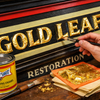Faux Marbling and Woodgraining: Lost Arts Revived with Wrights of Lymm
- by Sam Wozniak
Introduction: A Glimpse into Decorative History
In the grand interiors of centuries past, it wasn’t unusual to find intricate marble columns or lavish wooden panels that weren’t made of stone or rare hardwood at all. Instead, they were the work of master craftsmen skilled in faux marbling and woodgraining—decorative painting techniques designed to imitate the appearance of natural materials.
These arts, once essential for palaces, churches, and monumental architecture, fell out of common practice as industrial production and cheaper materials became available. However, thanks to renewed interest in craftsmanship, heritage design, and restoration, faux marbling and woodgraining are experiencing a revival.
Today, artisans and enthusiasts can recreate these luxurious effects using specialised tools and materials from Wrights of Lymm, as we are known for our exceptional paints, brushes, and goldleaf products.
The Lost Art of Faux Marbling
What Is Faux Marbling?
Faux marbling is a decorative painting technique that imitates the look of natural marble. Historically, it was used to elevate interiors without the cost or weight of real stone. From ancient Roman villas to Georgian townhouses, faux marbling has adorned everything from columns to fireplace surrounds.
Why It Disappeared—and Why It’s Returning
The decline of faux marbling coincided with mass-produced materials, but it’s making a comeback for two main reasons:
-
Heritage Restoration: Many historic buildings require accurate period finishes for authenticity.
-
Sustainable Luxury: Imitating marble reduces environmental impact while maintaining beauty.
The Timeless Craft of Woodgraining
What Is Woodgraining?
Woodgraining mimics the appearance of fine wood species on less expensive or more stable surfaces, such as softwoods or plaster. Craftsmen used specialist brushes, combs, and glazes to recreate natural patterns like oak, walnut, and mahogany.
Why It’s a Lost Art
The widespread availability of real wood veneer and printed laminates meant fewer artisans trained in this craft. Yet today, interior designers are rediscovering the charm and individuality of hand-crafted woodgrain effects.
Bringing These Arts Back with Wrights of Lymm
Wrights of Lymm, a historic UK supplier, offers high-quality materials perfect for recreating traditional faux finishes. Our product range supports every stage of the process—from preparation to embellishment with gold leaf.
Step-by-Step: Faux Marbling with Wrights of Lymm Products
1. Surface Preparation
Before applying paint effects, surfaces must be smooth and primed. Wrights of Lymm supplies professional-grade primers suitable for wood, plaster, or MDF.
2. Base Coat Application
Use a light base colour similar to the background tone of the marble you’re imitating. The range of heritage paints available provides authentic period shades.
3. Veining and Colour Layering
With artist brushes from Wrights of Lymm, apply thin, organic lines to mimic marble veins. Build layers of translucent glaze for depth.
4. Burnishing and Protection
Traditional marbling often involved gentle burnishing to give a stone-like sheen. For a high-end finish, add gilding accents around borders or inlay areas using 23.5 carat or 24 carat gold leaf for decorative detail.
Step-by-Step: Woodgraining with Wrights of Lymm Products
1. Choosing the Wood Effect
Decide on the species—oak, mahogany, or walnut—and select matching base paint from Wrights of Lymm’s heritage collection.
2. Applying the Base Colour
This should be the lightest tone of your chosen wood. Once dry, apply a tinted glaze.
3. Creating the Grain
Specialist woodgraining tools, available from Wrights of Lymm, can replicate distinctive patterns. Combs, brushes, and mottlers help produce realistic knots and growth lines.
4. Sealing the Finish
A clear varnish or shellac protects the grain effect and adds the sheen of polished timber.
Adding Gold Leaf for a Luxurious Touch
In both faux marbling and woodgraining, goldleaf is the ultimate embellishment. Wrights of Lymm stocks 23.5 carat and 24 carat gold leaf in loose and transfer forms, perfect for:
-
Decorative inlays in faux marble columns
-
Gilded borders on wood grained panels
-
Restoration of period cornices or mouldings
Why use 23.5 carat or 24 carat gold leaf?
-
24 carat offers unmatched purity and shine, ideal for interiors.
-
23.5 carat is slightly more durable, making it perfect for monumental or exterior gilding.
Practical Applications Today
These techniques are not just for museums or stately homes—they work beautifully in modern settings:
-
Faux Marbling: Kitchen islands, tabletops, fireplaces
-
Woodgraining: Interior doors, cabinetry, picture frames
-
Gold Leaf Accents: Statement walls, ceiling roses, or bespoke furniture pieces
Restoration Projects: Keeping History Alive
One of the most important uses for these skills is restoration. Many listed buildings require accurate decorative finishes to meet heritage standards. Wrights of Lymm’s products ensure authenticity, whether you’re replicating a Regency marble column or a Victorian oak door.
Why Wrights of Lymm Is the Go-To for Traditional Crafts
-
Expertise: Over 100 years supplying heritage materials
-
Quality: Professional-grade brushes, paints, and gilding products
-
Authenticity: True-to-period colours and finishes for restoration projects
From the monumental scale of church interiors to small domestic projects, their range makes it possible to revive these beautiful, historic techniques with confidence.
Conclusion: Reviving Elegance in the Modern Era
Faux marbling and woodgraining are more than decorative tricks—they are legacies of craftsmanship that deserve to be preserved. With the right tools, paints, and gold leaf from Wrights of Lymm, anyone from skilled artisans to dedicated DIYers can bring these lost arts back to life.
Whether you’re tackling a heritage restoration, adding gilding to a monumental project, or simply want to introduce timeless beauty into your home, now is the perfect time to rediscover these crafts.






